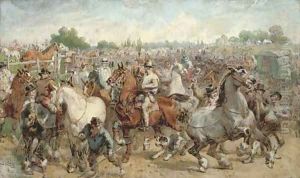Willam Powell Frith Paintings
William Powell Frith was a British painter born on January 19, 1819, in Aldfield, near Harrogate in North Yorkshire. He was renowned for his genre and narrative works, which were steeped in a fine detail that captured the essence of Victorian society. Frith was one of the most popular painters of the Victorian era, and his works enjoyed immense public acclaim during his lifetime.
Educated at various schools, including University College London, Frith showed an early interest in art. In 1835, he began his formal training at the Royal Academy of Arts and soon developed a style that melded the narrative richness of the old masters with the detailed observation of contemporary life. Frith's early work was influenced by the genre paintings of Wilkie, the landscapes of Constable, and the narrative scenes of Hogarth. However, he quickly found his own distinctive path.
Frith's career took a significant turn with the painting 'Ramsgate Sands' (1851-54), which depicted the Victorian middle class at leisure. This work was a resounding success and marked the beginning of his fame. It was followed by the even more ambitious and celebrated panoramas of modern life, notably 'The Derby Day' (1858) and 'The Railway Station' (1862), which were remarkable for their vast scale and the multitude of figures depicted. These paintings were among the first to represent the Victorian era's complex social hierarchy, from the working class to the aristocracy, all intermingled in public spaces.
Throughout his life, Frith was a prolific artist and also a member of the Royal Academy. He painted portraits, historical subjects, and literary scenes as well, but it is for his detailed and vibrant crowd scenes that he is best remembered. His narrative style and his ability to capture the minutiae of human interactions made his pictures fascinating to the public, who enjoyed identifying the various character types and social commentary inherent in his work.
William Powell Frith's later years saw him continue to paint and exhibit, though his popularity was somewhat eclipsed by the rise of the impressionist and modernist movements. He published his autobiography in 1887, providing valuable insights into his life and the Victorian art world. Frith died on November 2, 1909, in St John's Wood, London. His legacy is preserved in the collections of major museums across the United Kingdom, including the Tate Britain, the Royal Academy of Arts, and the Victoria and Albert Museum. His detailed, narrative-rich compositions remain an invaluable visual record of Victorian society.
